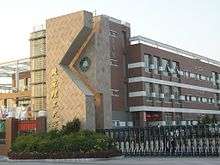Liangxiang, Beijing
Liangxiang (Chinese: 良乡地区; pinyin: Liángxiāng Dìqū) is a township of Beijing, Fangshan District, located 25km southwest of the city center. It has 80,000 registered inhabitants with local hukou and a total population of 112,000.[1] Covering approximately 69.2 square kilometres, Liangxiang is one of the largest subdistricts of Fangshan by land area.
History
Liangxiang county was established 2,000 years ago during the Qin Dynasty. Its name came from the Chinese saying '人物俱良', literally 'people and goods all gather in Liang', indicating significant economic activities in the past. As the land is relative fertile and flat, it was suitable for agriculture, contributing to its prosperity.[2] In 1958, Liangxiang county (良乡县) merged with Fangshan county and was renamed Liangxiang town (良乡镇). On January 24, 2002, another merger with Guandao (官道镇) took place. The new Liangxiang township became the political, cultural and economic centre of Fangshan district and houses the district seat.
Infrastructure

6th Ring Road and Jingshi Expressway have exist connecting to Liangxiang. A small military airport is situated next to one of the exits, in the northwest. Beijing-Guangzhou Railway pass through Liangxiang. Basic facilities such as postal offices, telecommunication offices, 2 day care centers, 14 primary and secondary schools and a hospital are also present.
Recently, a few universities including Capital Normal University, Beijing Institute of Technology, Capital University of Medical Sciences and Beijing Technology and Business University decided to open additional campuses in the new University Town of Liangxiang, which houses over 100,000 students.[3]
Public transportation access has improved since opening of the Fangshan subway line, with 4 stations within Liangxiang (Liangxiangnanguan Station, Liangxiang University Town North Station, Liangxiang University Town Station and Liangxiang University Town West Station). Bus lines 616, 646 and 917 can be used to get to Beijing city centre.
Culture
Historical heritages such as Haotian Pagoda, Yue Yi Tomb, Confusius Temple (良乡文庙) and Xiuyunguan (岫云观 or 良乡离宫) are popular tourist attractions.
Administrative divisions
Liangxiang contains 26 communities and 40 administrative villages (行政村).
References
- "Archived copy". Archived from the original on 2012-08-06. Retrieved 2012-07-15.CS1 maint: archived copy as title (link)
- "Archived copy". Archived from the original on 2012-05-27. Retrieved 2012-07-15.CS1 maint: archived copy as title (link)
